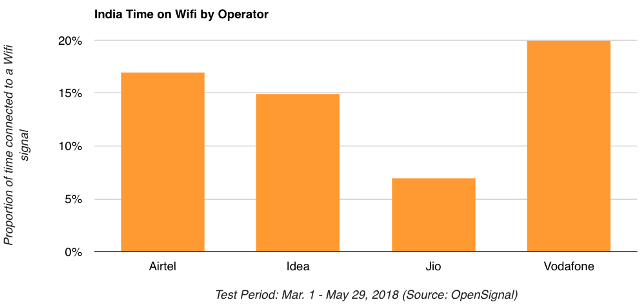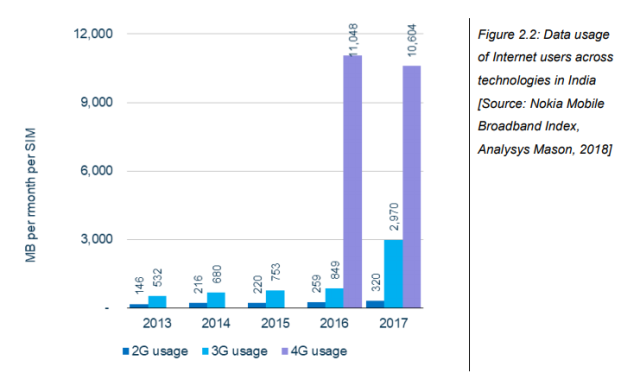OpenSignal in its latest report revealed the usage of smartphone customers on Wi-Fi on 4G LTE networks of Airtel, Idea, Vodafone and Reliance Jio.
 Users of Vodafone spend the 20 percent of the time connected to Wi-Fi networks.
Users of Vodafone spend the 20 percent of the time connected to Wi-Fi networks.
Airtel users spend 17 percent of the time on Wi-Fi networks.
Idea Cellular users spend 15 percent of the time on Wi-Fi networks.
Reliance Jio users spend 7 percent of the time on Wi-Fi networks.
The OpenSignal report has explained reasons for low Wi-Fi usage of customers on Reliance Jio network. Reliance Jio has invested $36 billion plus to build its telecom network in India tapping the mobile data customers with innovative pricing strategies.
OpenSignal in its State of Mobile Networks: India report said Jio’s 4G availability was 96.4 percent. “This explains why our users on its network are connecting to Wi-Fi less than those using its rivals. With that level of 4G connectivity, a lot of Jio customers may not be seeking out Wi-Fi connections even when they’re available,” OpenSignal said.
The chart below prepared by Analysys Mason shows the difference between data usage on 2G, 3G and 4G networks during 2013-2017. The Analysys Mason report indicated that there was a drop in 4G data consumption in 2017 vs 2016. In fact, data driven by 2G and 3G networks rose during this period.
 OpenSignal said Wi-Fi networks don’t get the same amount of interest in the subcontinent, as the evolution of telecoms has skipped the fixed-broadband stage of development and raced straight onto 4G.
OpenSignal said Wi-Fi networks don’t get the same amount of interest in the subcontinent, as the evolution of telecoms has skipped the fixed-broadband stage of development and raced straight onto 4G.
There are a significant number of Wi-Fi users in India connecting at home or at work, while publicly-accessible Wi-Fi is becoming more and more important as data use increases. India government is planning to provide public Wi-Fi coverage to 250,000 local administrative offices and 5,000 railway stations within the next two years.
Wi-Fi connectivity in India is well below more developed markets such as the U.S. where OpenSignal has measured Wi-Fi connectivity around the 50 percent mark.
The report said one of the key reasons for the relatively low Wi-Fi connectivity in India is the limited penetration of home broadband. In Europe in particular, large numbers of subscribers buy their mobile, broadband, and TV services from one operator. Since this business model is not affordable for most Indians, operators have chosen to concentrate on mobile as opposed to fixed-line networks.
This may also explain why users on Jio’s mobile network spend significantly less time on Wi-Fi compared to its rivals, since the operator has only just launched its JioFiber home broadband service.
India’s 4G networks become more congested and mobile operators started launching Wi-Fi offload programs, encouraging users to switch to using Wi-Fi hotspots with low-cost data offers. Since these offers are new and hotspots are scarce, it is unlikely they have yet made much of an impact on our Wi-Fi connectivity measurements.
The report said India has seen considerable growth in its mobile networks in the past few years, catapulting it into the top 20 of the countries for 4G availability. 4G speeds in the country are still among the slowest, as LTE networks’ capacity has yet to catch up with reach.





